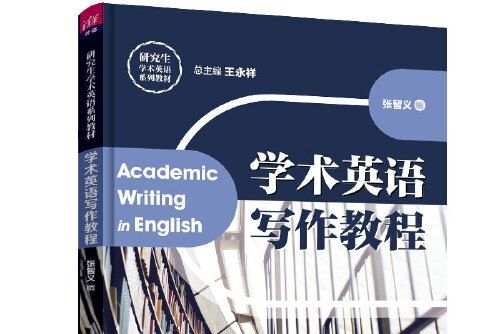《學術英語寫作教程/研究生學術英語系列教材》是2019年9月清華大學出版社出版的圖書,作者是王永祥、張智義,該書主要介紹了學術論文的文體風格,以步驟和階段思想介紹學術論文各部分內容的寫作要點和行文規範等。
基本介紹
- 中文名:學術英語寫作教程/研究生學術英語系列教材
- 作者:王永祥、張智義
- 出版社:清華大學出版社
- ISBN:9787302531418

《學術英語寫作教程/研究生學術英語系列教材》是2019年9月清華大學出版社出版的圖書,作者是王永祥、張智義,該書主要介紹了學術論文的文體風格,以步驟和階段思想介紹學術論文各部分內容的寫作要點和行文規範等。
《學術英語寫作教程/研究生學術英語系列教材》是2019年9月清華大學出版社出版的圖書,作者是王永祥、張智義,該書主要介紹了學術論文的文體風格,以步驟和階段思想介紹學術論文各部分內容的寫作要點和行文規範等。內容簡介全書共十...
《學術英語寫作教程》是2011年高等教育出版社出版的圖書,作者是 《大學英語選修課學科課程系列教材》項目組。本書拓展英語學習的渠道,增加語言練習的機會,提高語言輸入和輸出的質量。內容簡介 《學術英語寫作教程(修訂版)》講述了:隨著...
《學術英語寫作教程》是2012年浙江大學出版社出版的圖書,作者殷小琴,本書主要講解了學術英語的寫作方法與技巧,內容主要包括學術英語的要求與規範、段落與引用方法、圖表與短文寫作等。內容簡介 內容主要包括:前言(包括編寫本書的目的及其...
《通用學術英語寫作教程》是2015年8月復旦大學出版社出版的圖書,作者是蔡基剛。內容簡介 通用學術英語和通用英語都是語言學習課程,都是在繼續提高學生英語綜合語言技能,因此,在學習起始水平和課程難度上並無太大的差異。這可以從全國近...
《英語學術論文寫作教程》是2011年7月1日中國農業大學出版社出版的圖書,作者是胡友珍。內容簡介 由胡友珍、何小平和王志芳編著的《英語學術論文寫作教程》以教育部頒布的《非英語專業研究生英語教學大綱》為依據,根據我國和我校博士研究...
《學術英語寫作綜合教程(第2版)》根據對中高級階段的英語學習者的實際情況及海內外學者英語寫作文本的分析和研究,圍繞學術英語寫作技能,從句、段、篇等方面組織學習內容,以滿足本科生和研究生階段英語寫作技能的各項學習需求;同時,...
《學術英語寫作基礎教程》既可作為學術論文寫作的教學用書,也可作為英語專業高年級選修課或青年教師學術培訓的選用教材。圖書目錄 Unit 1 Features of Academic Writing 1.1 Complexity 1.2 Formality 1.3 Objectivity 1.4 Explicitness ...
《英語專業學術論文寫作教程》是2010年12月由華中科技大學出版社出版的書籍,作者是文斌。本書主要介紹了用英語寫專業論文的框架結構及寫作步驟,寫作要點等。內容簡介 《英語專業學術論文寫作教程》主要圍繞三條主線展開。這三條主線分別是...
《新世紀標準大學英語學術英語寫作教程》是《學術英語寫作教程》學生用書,約需48學時,供一個學期教學使用。主要適用於本科高年級或通過大學英語四級考試的學生使用,也可用於研究生英語選修課程。本教程還適用於自修和準備到國外留學的人員...
《英語學術論文寫作教程》是2017年9月中國人民大學出版社出版的圖書,作者是李芝。內容簡介 本教材的編寫原則在於通過分析不同學科的學術論文篇章語言特徵共性,讓學生在閱讀學術論文的過程中掌握行文規範,幫助學生直觀地分析和掌握英文學術...
《英語寫作教程·學術論文》從學術論文寫作理論出發,結合大量的寫作案例,提供了詳盡、實用的學術論文寫作指導,非常適合高校學術研究學習者(高年級本科生和研究生)、學術會議參會者、學術期刊投稿者等需要撰寫英文學術論文的讀者。全書共11...
《通用學術英語寫作(高階)(研究生通用學術英語系列教程)》作為學術寫作的高階教材,既可供高校教師、研究生(博士生、碩士生)、高年級本科生以及相關科研人員學習使用,也可用於對國際學術會議參會人員的培訓。《通用學術英語寫作(高...
《新視線國際英語學術論文寫作教程》是2011年北京語言大學出版社出版的圖書,作者是柯伊爾、勞爾。作者簡介 作者:(美國)柯伊爾(William Coyle) (美國)勞爾(Joe Law)內容簡介 《新視線國際英語學術論文寫作教程(第15版)》特點:新...
《英語學術論文寫作1》是2004年高等教育出版社出版的圖書,作者是秦秀白、劉洊波。內容簡介 《學術論文寫作》是高等學校英語專業知識必修課,是學生學習和掌握英文論文寫作語言和格式的基礎教程,其目的是為學生課程論文的寫作打下堅實基礎,為...
本寫作教程里的每個單元由四部分組成,以任務教學法的方式分別訓練學生的語言技能、實用交際文種、學術論文寫作基本方法等,並緊扣《教學大綱》對六級、八級的寫作要求,分不同步,驟訓練學生撰寫各種正式文種和1500—3000英語單詞的小論文,...
《學術英語讀寫教程》是2018年外語教學與研究出版社出版的圖書。作者是鮑志坤。本書通過六個單元覆蓋英語學術論文的每個環節,系統訓練英語學術論文的閱讀和寫作。內容簡介 全書共六個單元,每個單元分為三部分。部分分別介紹英語學術論文的...
《研究生學術英語通用教程/21世紀多維英語規劃教材》是“21世紀多維英語規劃教材”之一,針對研究生在英語學習和國際學術交流中經常出現的短板,精心設計了有關英語學術寫作的重要話題。《研究生學術英語通用教程/21世紀多維英語規劃教材》以...
《英語專業畢業學術論文寫作教程》是張霖欣所著的一本圖書,於河南人民出版社出版。內容提要 高校教材 圖書目錄 第一章 畢業論文概說 1.1 “畢業論文”與“學術論文”1.2 畢業(學術)論文的特徵 1.3 為什麼要寫畢業論文 1.4 英語...
《普通學術英語教程:閱讀、寫作與思考》是2013年北京大學出版社出版的圖書。內容簡介 學術英語教學既應注重思維方式的培養,也要注重語言表達的得體與嚴謹。通過本.書的撰寫,我們希望大學英語課堂能培養學生思辨能力,提高語言能力,從而...
《學術英語寫作》作者是韓金龍,朱琳,是2020年華南理工大學出版社出版的圖書,本書主要講述了教材設計了相應內容來幫助學生了解該部分的內容,並給出相關寫作任務讓學生進行操練。內容簡介 本教材旨在讓學生學會如何從查找文獻、提煉觀點,到...
《學術英語讀寫教程(上)》針對國內大學生對英語綜合套用能力及學術思維創新能力的需求,依據認知語言學的基本理念設計編寫而成。教材從閱讀典型篇章的經驗出發,讓讀者學習各種體裁文章的巨觀結構發展、內在邏輯脈絡、微觀詞句知識,再轉而...
《英語學術論文寫作(第三版)》是2019年中國人民大學出版社出版的圖書。 內容簡介 《英語學術論文寫作(第三版)/21世紀實用研究生英語系列教程》共分七章,每章三單元。每章主要圍繞三條主線展開。這三條主線涵蓋了論文寫作的主要步驟...
《高級英文寫作教程:論文寫作》根據國家英語專業教學大綱要求,依據現代寫作理論,系統闡述了英語作文的獨特結構與思想表達方式,以提高學生的寫作能力,《高級英文寫作教程:論文寫作》包括八個單元,分門別類地訓練學生掌握學術論文的各種論述...
《英語專業畢業論文寫作教程》是2007年03月華中科技大學出版社出版的圖書。該書研習英語學術論文寫作理論,反覆徵求教師和學生的意見,通過開座談會,作問卷調查,並歸納總結而寫成的,力求全面、詳細地介紹和闡述畢業論文撰寫的全過程。內容...
通過研讀樣文,討論學術語言及語篇的特點。4.通過收集學生的文章, 實例分析其錯誤的表達。作者簡介 陸紅,南京航空航天大學副教授, 從事研究生英語寫作教學,出版的教材有《研究生英語寫作教程》《實用英語寫作》。
本書依據“產出導向法”的教學理論,將“輸出驅動”和“輸入促成”有機結合,以訓練學生掌握各學科中通用的讀、寫等學術英語技能,開拓其國際視野。本書每個單元包括學術閱讀和學術寫作兩大模組。學術閱讀模組每單元圍繞一個主題,包括教育...
主編 於華:中國科學院大學外語系副教授,從事碩士、博士研究生英語教學近20年,科研方向主要包括英語文體學、英語寫作教學與研究等。主編 姜文東,中國科學院大學外語系教授,碩士生導師,英國朴茨茅斯大學訪問學者,多年從事研究生公共外語...
《英語論文寫作教程》是2003年1月由清華大學出版社出版的圖書,作者是戴福林。作品目錄 Chapter 1: Introduction Chapter 2: Analysing the writing situation Chapter 3: Brainstorming,planning and drafting Chapter 4: Convincing others-...
本書是《綜合學術英語教程4》的教師用書,本書依據總主編蔡基剛的學術英語教學理念和思路設計,供教師教學和學生自學使用。本書圍繞第四冊教材中“論文題目擬定、研究問題設計、論文資源搜尋、文獻綜述寫作、口頭報告準備、論文摘要撰寫和參考...
